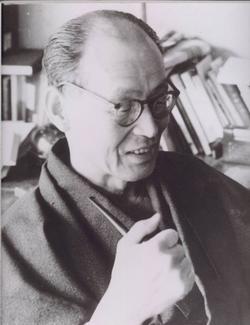Suzuki Yasuzo

Suzuki Yasuzo, 1904 – 1983
Suzuki Yasuzo was born on March 3, 1904, to his father Yoshio and his mother Rui in Odaka Town (now Odaka District, Minamisoma).
He entered Soma Junior High School in April of 1917 and was active in the debate club. He became the champion of the Prefectural Secondary School Association 1st Oratory Tournament, as well as the 1st Tohoku Junior High Association Oratorical Meeting sponsored by Sendai 2nd High School. He was also a leader in a student strike aiming to expel upperclassmen who were acting violently towards lowerclassmen, and helped eliminate violence within the school.
In April of 1921 he entered Sendai 2nd High School, where he met Kurihara Tasuku. He became deeply concerned with social issues and entered the Kyoto Imperial University, literature department, in April of 1924. He devoted himself to working in the Kyoto Imperial University Social Science Research Society. He also came into contact with Marxism and held seminars, lectures, and research paper meetings centered around the subject.
He transferred to the economics department and devoted himself to the study of Marxist theory and the implementation of proletarian education. It was at this time that the activities of the Kyoto Imperial University Social Science Research Society were deemed in violation of Article 2 of the Peace Preservation Law, and Suzuki was arrested (January 18, 1926). This was the first incident in which the Peace Preservation Act was applied, and became known as the Japan Student Social Studies Federation Incident. Suzuki was found guilty and spent 2 years in incarceration.
He voluntarily dropped out of the university and began research into constitutional law and political science. However, his activities related to the 2nd Proletarian Newspaper were deemed in violation of the Peace Preservation Law, and he was arrested once again (October 21, 1929).
While in prison he read the writings of constitutional scholars sent to him by his wife Toshiko, and formed a research plan related to constitutional law. He also wrote tankas, 31-syllable Japanese poems, loaded with various emotions.
After being released from prison, he began working on all-out research into constitutional law, and published “Historical Study of the Constitution” in 1933. However, it was deemed in violation of the publication law at the time, and sales were prohibited on the same day as it was published.
With the surrender of Japan, Suzuki launched the Constitution Research Society, took on the role of coordinator, and drafted the “Constitution Draft Guidelines” (憲法草案要綱, Kenpou Souan Youkou), all on September 5, 1945. This was translated into English by the Supreme Commander for the Allied Powers (also known as General Headquarters), and consulted during the drafting of the Constitution of Japan.
After that, Suzuki served as the director of the Japan Political Science Association, and was employed as a professor consecutively at Shizuoka University, Aichi University, and Rissho University. He passed away on August 7, 1983, at the age of 79.
- この記事に関するお問い合わせ先
- このページに関するアンケート
-
より良いウェブサイトにするために、このページのご感想をお聞かせください。















更新日:2021年03月26日